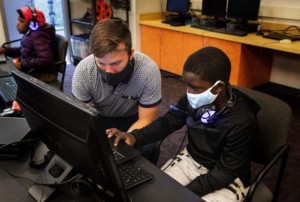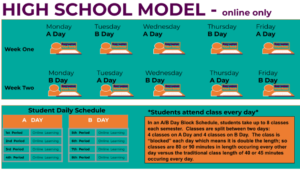Engaging Families During Distance Learning

By: Erin Gohl and Kristen Thorson
Decades of research and practical experience have shown that family engagement in student learning is an important component for positive outcomes. With so many school districts around the country beginning the fall with distance learning, the role of families has become even more critical. Parents and caregivers are now serving as the conduits connecting students to school and learning, the facilitators ensuring that learning experiences are productive, and the managers of the school routine. At the same time, the pandemic has disrupted many of the traditional opportunities teachers have to connect and engage with families such as back-to-school nights or open house events.
As schools plan for a virtual reopening, educators must consider and plan for how to connect, engage, and support as they partner with families within this unique context. In doing this, it is essential that both schools and classrooms immediately build strong relationships, establish two-way communication channels, and ensure that their family engagement strategies are ongoing and equitable for all families.
Introduce students and families to the classroom and school. Feeling part of a classroom and school community is important for students and families. Being able to visualize the physical space of the school and the classroom, even while learning from home, establishes a common point of connection and conveys a sense of structure. Some districts around the country are encouraging school leaders and teachers to conduct virtual learning from classrooms within the school building, so familiarizing students with this setup helps to organize their learning routines. Educators can consider hosting live video conferences or sharing pre-recorded videos to orient students and families with the physical spaces.
Share photos and video messages to introduce school leaders and support staff. The experience for families facilitating virtual learning can be isolating. Without the beginning of the year introductions, families might not realize that there is a broader team working behind the scenes to support learning and growth for each student. Take care to introduce school leaders and building-wide specialists and share relevant contact information. It is important for families to proactively get to know the team of support available for their child’s learning. Similarly, consider including photos to identify individuals with introductory messaging and on the school’s website. This is a great way to personalize messaging and help parents feel a greater sense of community.
Take time to educate families on how they can best support learning. Teachers have built their professional knowledge base over years of training and classroom experiences. Most parents and caregivers do not have this background knowledge. Beyond communicating the logistics of virtual learning, it is important to invest time in educating parents and caregivers on developmentally appropriate strategies and expectations for learning. Guide parents on the importance of taking breaks from learning and communicate that it is both necessary and productive for children to take learning breaks throughout the day. You might share how to recognize some cues that a child needs a break and give strategies on how to structure a quick break. Throughout the year, as you introduce new content, parents and caregivers may also require more detailed academic information given this structure of learning in order to support their children. You might include how-to guides for math and reading work at home in your parent outreach.
Value input from parents to inform teaching and learning. Given parents’ increased role in student learning, it is very important to create a two-way communication channel so that they can reach out with questions or share information and concerns. In the classroom, teachers rely on many informal observations and assessments to gauge student learning and progress. With learning happening virtually, teachers must partner with parents and caregivers to better understand student needs.
Find ways to cultivate relationships. Relationships and shared experiences among students, families, and staff are at the heart of a vibrant school community. Find ways to connect new families to the school community. Use virtual school-wide morning announcements, theme days, and scheduled bedtime stories to add points of connection with staff and community members. You might also partner veteran parents with new families to serve as a resource for questions and guidance or connect families from the same classroom by hosting a virtual event.
Create opportunities for parent contribution and volunteering. Each school community is filled with individuals who have a variety of skills and interests along with a desire to contribute to the classroom and school community. Educators can still utilize these contributions of time and talent. You might invite parents to join a virtual lesson and play a musical instrument for the class, share information about their job, or even lead an art project. This is a great way to extend the resources available to students and strengthen the classroom and school community.
Investing in Family Engagement. Both educators and families are actively preparing for a back-to-school season like no other. Educators are figuring out how to migrate the dynamic process of teaching and learning to the digital realm. Families are redesigning their home spaces and schedules to accommodate virtual learning. Practices and routines that in prior years were taken for granted are now having to be reimagined and designed to fit this new structure. And all of this work is happening within a broader context of health concerns and financial impacts.
As educators and families prepare for this school year, we cannot forget to invest time and energy into building and fortifying the relationships between home and school. For within this context, those relationships and communication channels will be the foundation that makes the rest of the work possible and productive. With the recognition of the importance of these family-school partnerships, educators may even develop best practices and strategies that will serve students and families well beyond the return to in-person schooling. And with the recognition that family engagement is an essential rather than ancillary component of schooling, we might finally realize the potential of true partnerships between families and schools described in decades of research.
For more, see:
- 5 Research-Based Recommendations for Remote Learning: Lessons from LUSD
- It’s Time to Prepare for COVID-19 Resurgence:Six Steps Your School Can Take Times
- 4 Ways Leaders Can Support Teachers in Challenging Times
Stay in-the-know with innovations in learning by signing up for the weekly Smart Update.








Bailey
I really enjoyed this blog post! I think that it is very important to include parents in the new way of learning.
Deepithi Guvva
Thanks for sharing this fantastic article. we are Digital teacher is your personal digital tutor which helps you to visualize the tougher concepts in a simpler way through animations, videos and voice over for better understanding.